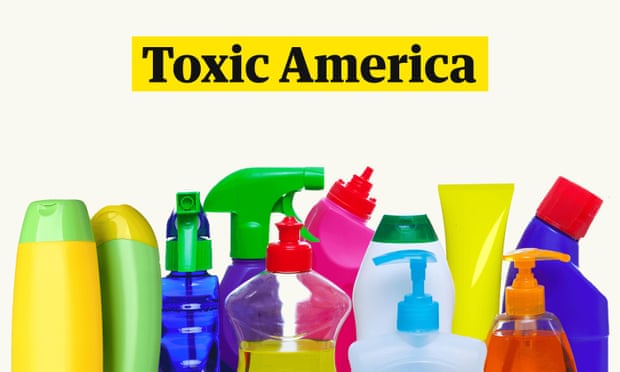A brief but telling piece of legislation was put forward in Connecticut in January. Just three lines in length, the bill calls for any cosmetics in the state to “meet the chemical safety standards established by the European Union”.
The move, unlikely to be made law, is the latest signal of mounting anguish over the enfeebled regulation of everyday products in the US compared with European countries. Across a span of cosmetics, including makeup, toothpaste and shampoo, to items ranging from household cleaners to fruit juice to cheese, hundreds of potentially harmful ingredients banned in the EU are legally allowed in the US.
“Many Americans are unaware that they are absorbing untested and unsafe chemicals in their products,” said Alex Bergstein, a state senator who put forward the Connecticut legislation. Bergstein was previously the chair of the Mount Sinai Children’s Environmental health center.
“Generally, the EU has got it right. In the US we have a strong favouritism towards companies and manufacturers, to the extent that public health and the environment is being harmed. The pendulum has swung in an extreme way and it’s really going to take a general awakening by the public.”
The disparity in standards between the EU and US has grown to the extent it touches almost every element of most Americans’ lives. In cosmetics alone, the EU has banned or restricted more than 1,300 chemicals while the US has outlawed or curbed just 11.
It’s possible to find formaldehyde, a known carcinogen banned in EU-sold cosmetics, in US hair-straightening treatments and nail polish. Parabens, linked to reproductive problems, are ruled out in the EU but not the US, where they lurk in skin and hair products. Coal tar dyes can be found in Americans’ eyeshadow, years after they were banned in the EU and Canada.
“In the US it’s really a buyer beware situation,” said Janet Nudelman, director of the Campaign for Safe Cosmetics. “Cosmetics companies can use any raw material that they like and there’s no way to know if they are safe before they reach the shelves. The contrast with the EU is stark and troubling.”
At the heart of the EU’s approach is what as known as its Reach (Registration, Evaluation, Authorisation and Restriction of Chemicals) laws which require manufacturers to prove to regulators that a product is safe before it can be used. The US has similar rules for new chemicals entering the market but no such precautionary principles for the thousands of potential toxins already in use.
This means that certain dyes used in cheese, chocolates and juice are restricted in some European countries such as the UK – where a 2007 study found some artificial colors and preservatives are linked to increased hyperactivity in children – but not the US. Atrazine is the most widely used herbicide in the US but has been banned in Europe since 2003 due to concerns it pollutes water. Lead-based paints were banned in much of Europe before the second world war but it took the US until 1978 to follow suit.

Asbestos exposure has long been known to cause deaths and illnesses but the substance is still not banned in the US. The Environmental Protection Agency (EPA) attempted to do so in 1989 only to be overturned by the federal court following a backlash from manufacturers.
The clout of powerful industry interests, combined with a regulatory system that demands a high level of proof of harm before any action is taken, has led to the American public being routinely exposed to chemicals that have been rubbed out of the lives of people in countries such as the UK, Germany and France.
“When the asbestos ban got overturned the EPA got nervous about banning anything,” said Molly Jacobs, a senior researcher at the Lowell Center for Sustainable Production. “That was the last time the EPA sought very strict restrictions on industrial chemicals. The EU definitely has stronger policies.”
Of the more than 40,000 chemicals on the market in the US, the EPA has only banned six, including polychlorinated biphenyls (known as PCBs) which are linked to cancers, certain aerosol sprays blamed for the hole in the ozone layer and dioxins, used as an ingredient in Agent Orange, which the US sprayed during the Vietnam war.
Under a 1976 law called the Toxic Substances Control Act (TSCA) the EPA has the power to limit chemicals, but critics say it is severely flawed. The act largely focuses on new potential toxins and even then gives the EPA just 90 days to work out if new products pose a risk before they hit the market.
A 2016 amendment known as the Lautenberg Act required the EPA to evaluate all potentially risky chemicals, but progress on this backlog has often appeared painfully slow. “The EPA is playing catchup, and under this administration things aren’t moving very fast at all,” said Jacobs.
The EPA recently listed 40 chemicals to be assessed for review, including asbestos, formaldehyde and trichloroethylene, which is used in refrigeration and can cause damage to the nervous system and liver. Andrew Wheeler, administrator of the EPA, said the agency was committed to the “successful and timely implementation” of the Lautenberg Act.
Q&AWhy the Guardian is launching a major reader-funded project on the toxicity of modern life
Show

Pesticides in your breakfast cereal. Carcinogenic chemicals in your furniture, and contaminated drinking water.
Welcome to Toxic America – a Guardian project which will explore the health implications of living in an environment that can expose all of us to chemical contamination on a daily basis through the air we breathe, the food we eat, the products we use and the water we drink.
The American public is routinely exposed to toxic chemicals that have long been banned in countries such as the UK, Germany and France.
Of the more than 40,000 chemicals used in consumer products in the US, according to the EPA, less than 1% have been rigorously tested for human safety. Under the Trump administration there are signs it’s only getting worse.
The Guardian is asking our readers to help us raise $150,000 to increase our coverage of the toxic chemicals in our environment for the rest of 2019.
This series will investigate the ways in which chemicals in our water, food and environment can impair growth, development and health, causing a toxic fallout that can include: cognitive and behavioural difficulties, obesity, diabetes, infertility and birth defects.
We will also examine the power of the $640bn chemical industry – which has a lobby that’s currently better funded than the NRA.
If we hit our fundraising goal by 30 June, the six-month project will include dozens of articles, videos, opinion pieces and visual stories over the course of 2019. We hope you’ll consider making a contribution.
But while the process has lagged, deaths have mounted. More than 50 deaths in the US since the 1980s have been linked to methylene chloride, a lethal ingredient of paint stripper that has been banned in the EU. The EPA recently got around to banning the chemical from consumer use after a group of retailers voluntarily removed it from shelves.
It will still be allowed for commercial use, however. “I am deeply disappointed that the EPA has decided to weaken its proposed ban on methylene chloride,” said Wendy Hartley, whose 21-year-old son Kevin died two years ago while using paint stripper on a bathtub, even after receiving training and wearing a protective mask. Hartley is one of two mothers who are suing the EPA claiming that their sons died while using the paint stripper.
“Workers who use methylene chloride will now be left unprotected and at risk of health issues or death. I will continue my fight until the EPA does its job.”
But even within the Trump administration, characterized by its zeal for deregulation, there is frustration that regulators have not been able to intervene as strongly as their EU counterparts. The Food and Drug Administration (FDA) recently found asbestos in Claire’s cosmetics but could do little when the company refused to recall the products. Claire’s subsequently withdrew the eyeshadows and compact powders voluntarily.
Scott Gottlieb, the departing FDA commissioner, said the episode showed that cosmetics regulations unchanged since 1938 are “outdated” and need to be overhauled to ensure public health.
“To be clear, there are currently no legal requirements for any cosmetic manufacturer marketing products to American consumers to test their products for safety,” Gottlieb said. “This means that ultimately a cosmetic manufacturer can decide if they’d like to test their product for safety and register it with the FDA.”
In lieu of any new laws, consumer advocates want federal agencies to act more aggressively and defy chemical industry lobbyists. They concede, however, a more likely recourse is an upwelling of public outrage at the risks faced in mundanities such as applying makeup or eating lunch.
“I’m hoping for dramatic changes in our politics but there’s little chance of that,” said Bergstein. “The federal government is barely functioning, so consumers have to realize they have the power to become more vocal and demand change. The awareness is still not there, though.”
This article has been updated to correct the date of the Lautenberg Act
